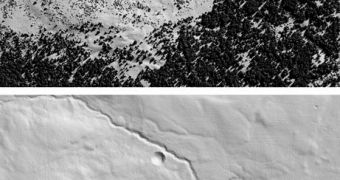It was about the year 900 AD when a large, tree log-sized meteor smashed on the surface of the Earth in a western region of Canada, leaving a large scar as an amphitheater-shaped crater. It still lies there today, filled with small meteorite pieces, under a thick blanket of trees, as a research indicates. The meteorite was compact upon collision, unlike other regular similar rocks which usually break in the atmosphere and pulverize on impact.
"You need to have that wallop," explained the author of the study, Christopher Herd, an associate professor of Earth and atmospheric sciences at Edmonton's University of Alberta, cited by National Geographic. "You need to have that big mass still going fast in order to make the crater." Meteorites are pieces of asteroids that make it to planets more frequently, and they have spawned about 175 craters on our planet throughout its history.
Two deer hunters found four metal fragments using a metal detector at the location of the crater. When Herd was announced, he admits he was rather skeptical at the beginning, but that changed when he was presented the fragments. "That told us right away that we are dealing with something quite interesting and quite unique," shared the scientist. "Here we have a crater and we also have meteorites associated with it. There are only a dozen impact craters in the world that have that association."
But the amount and thickness of the trees at the site prevented further, more thorough studies. Luckily, Herd's colleague Duane Froese proposed using an aerial survey technique named LiDAR, which provides accurate images of just the surface of the Earth, without its tree clothing. "The crater shows up beautifully as a nice, bowl-shaped structure" 120 feet (36 meters) wide and 20 feet (6 meters) deep, announced Herd, which means the original meteorite was about 3 feet (1 meter) wide. Perhaps using this technology will allow the discovery of more such craters all over the world.

 14 DAY TRIAL //
14 DAY TRIAL //